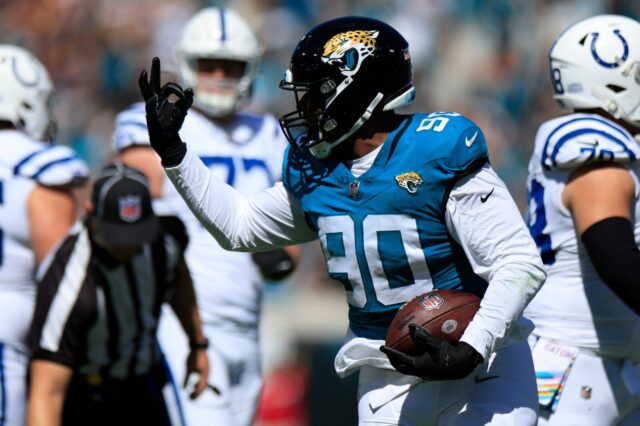This isn’t the MLB, where franchises run themselves under an unlimited salary cap, or even the NBA, where team’s are allowed to pay extra to exceed the soft salary cap.
This is the NFL, and the salary cap isn’t budging.
The hard salary cap is one of the aspects that makes the NFL so great; it allows every team, regardless of market size, to have an equal chance at competing year in and year out. Unfortunately, it also forces teams to budget their money wisely and, ultimately, make tough decisions.
The Denver Broncos are currently in this position with Von Miller, as they are in the process of trying to negotiate a long-term contract.
During this process, much of the public has taken Miller’s side, trying to force the Broncos’ hand while creating a simple rhetoric: “Just pay Von.” Now, if this were the MLB or the NBA, it would be hard to argue against this. But since the Broncos have a strict budget, taking a hard stance in negotiations is an absolute must if the franchise wants to maintain their championship aspirations for years to come.
For the 2016 season, the league’s salary cap is projected to be $155.27 million, and (including Von’s $14.1 million under the franchise tag) the Broncos are currently just $5 million under the line, according to Spotrac. With the reported six-year $114 million contract offered to Miller, with $38 million guaranteed, the Broncos would make him the highest paid non-quarterback in NFL history, with an annual average of just over $19 million, and push themselves right up to the salary cap ceiling. In other words, the Broncos would be spending 12 percent of their cap on one player.
The tie up between the two sides is with the amount of guaranteed money. The Broncos are currently willing to give a guaranteed $38 million over the first two years, but Miller is presumed to want that and at least another $19 million guaranteed for the third year as well.
While there is no doubt that every Broncos fan wants to see Miller locked up as a Bronco for the long term, it’s not worth overpaying him and putting the franchise in jeopardy for years to come.
The main argument from people wanting to pay Miller starts and ends with his dominant postseason run last year. They point to him single-handedly winning Super Bowl 50 for the Broncos, and they claim he deserves to be rewarded for the championship. While Miller was incredible — MVP of the Super Bowl — it wasn’t as if Miller didn’t get paid for his services last year. Last year, Miller made $9.75 million while having a good, but not all-world regular season, racking up 11 sacks.
In fact, in Miller’s five-year career with the Broncos, he has only been in the top five in sacks — the most important statistic for his position — once: 2012, when he had 18.5 and ranked third in the league. But he has fallen short every other year. For his career, Miller averages 12 sacks per year, which for a five-year period is very good, but does not lead the league.
Additionally, going into last postseason, Miller only had 1.5 career playoff sacks (four games). Simply wanting to make Miller the highest-paid non-quarterback ever just based off his outstanding postseason last year could put the Broncos in a risky situation down the road. Just look at Joe Flacco and the Baltimore Ravens.
In 2012, Flacco had one of the best postseasons in the history of the game, throwing 11 touchdowns, zero interceptions and guiding the Ravens to a Super Bowl victory as the MVP of the game — dominance equivalent to Miller’s. That offseason, the Ravens signed Flacco to the largest contract ever: six-years, $120 million. Since then, in the past three seasons, the Ravens have gone 23-25 with only one winning season. While this wasn’t all due to Flacco’s massive deal, it’s hard not to see how paying so much money to one player could cripple the rest of the team.
Additionally, during the 2015 season, of the 10 highest-paid non-quarterbacks, only two made the playoffs — J.J. Watt and A.J. Green — while the other eight fell short. Again, this isn’t necessarily the main reason why the other teams didn’t make the playoffs, but it also isn’t fair to think that it had nothing to do with it.
If the Broncos and Miller do agree a long-term extension, around $19 million per year for a guarantee of at least three years, it is important to understand how this relates to the rest of the team. Here are a few notable Bronco cap hits for the 2016 season: Aqib Talib $9.96 million, Chris Harris Jr. $9 million, DeMarcus Ware $8.01 million, Derek Wolfe $6.8 million, Emmanuel Sanders $6.6 million, C.J. Anderson $6 million, Russell Okung $5.2 million and Darien Stewart $3.25 million.
Every single player mentioned above is slated to be a starter on the team and will have a cap hit less than half of what Miller would average. To put this in perspective, Miller’s $19 million would be fairly equivalent to having Okung, Wolfe and Sanders or having two of the best corners in the NFL — Talib and Harris Jr.
While there’s no questioning Miller’s abilities and talents, there are many factors that general manager John Elway has to take into account when negotiating a long-term deal with Miller. Even though it seems as if Elway may be playing the negotiating game too hard, he is only doing this to protect the future of the Broncos franchise. It is important to remember that Miller and his agent only have Miller’s interest in mind, not the Broncos.
If fans want to continue to see a championship-caliber franchise in Denver for years to come, the rhetoric needs to change from “Just pay Von” to what has given the Broncos impeccable success the last five years: “Trust in Elway.”



